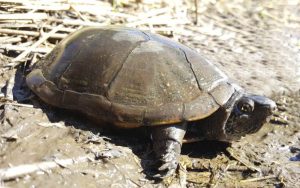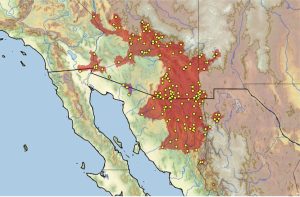Kinosternon sonoriense, 119
Kinosternon sonoriense (LeConte 1854) –
Sonora Mud Turtle, Desert Mud Turtle,
Sonoyta Mud Turtle, Casquito de Sonora
Paul A. Stone1, Justin D. Congdon2, Marie E.B. Stone1,
James N. Stuart3, John B. Iverson4, and Philip C. Rosen5
1Department of Biology, University of Central Oklahoma,
Edmond, Oklahoma 73034 USA [[email protected]; [email protected]];
2University of Georgia Savannah River Ecology Laboratory, Drawer E, Aiken, South Carolina 29804 USA,
Present Address: 66 Camino Nacozari, Rio Rico, Arizona 85648 USA [[email protected]];
3New Mexico Department of Game & Fish,
1 Wildlife Way, Santa Fe, New Mexico 87507 USA [[email protected]];
4Department of Biology, Earlham College, Richmond, Indiana 47374 USA [[email protected]];
5School of Natural Resources, University of Arizona, Tucson, Arizona 85721 USA [Deceased]
Summary. – The Sonora Mud Turtle, Kinosternon sonoriense (Family Kinosternidae), is a medium-sized kinosternid (females to 175 mm SCL, males to 168 mm SCL) found in lentic and lotic aquatic habitats in desert and montane regions of the southwestern United States and northwestern Mexico. Two allopatric subspecies are currently recognized, K. s. sonoriense and K. s. longifemorale. Although primarily aquatic, individuals frequently move along aquatic corridors, make extensive overland movements, and estivate on land. Kinosternon sonoriense is omnivorous, matures in 5–9 yrs, and exhibits considerable geographic variation in growth and maturation. Average clutch size is usually related to female body size and ranges from 3 to 11 eggs. Eggs average 28–33 mm in length, 14–19 mm in width, and weigh 5–6 g. Females produce one to two clutches per year (potential maximum of four), and embryos exhibit temperature-dependent sex determination. The loss and degradation of natural aquatic habitats, including streams, spring runs, and ciénegas, is a primary threat to conservation of K. sonoriense, particularly to the very small, isolated populations of K. s. longifemorale. The loss of natural habitats has been partially mitigated by the widespread construction of impoundments; however, many impoundments are now experiencing dam failure and siltation, further contributing to habitat loss. In addition, the establishment of non-native predator species, particularly Virile Crayfish and American Bullfrogs, are known threats to juvenile K. s. sonoriense. The status and ecology of both subspecies have been studied in recent years, mainly in the United States, and conservation efforts have been focused primarily on the declining populations of K. s. longifemorale.
Distribution. – Mexico, USA. Kinosternon sonoriense occurs from southwestern New Mexico and western Chihuahua west through much of Arizona and Sonora. Historically known populations in the lower Colorado River basin of southwestern Arizona, southeastern California, and possibly northern Baja California and southern Nevada have apparently been extirpated.
Synonymy. – Kinosternum sonoriense LeConte 1854, Cinosternum sonoriense, Cinosternon sonoriense, Thyrosternum sonoriense, Kinosternon sonoriense, Kinosternum henrici LeConte 1859, Cinosternum henrici, Cinosternon henrici, Swanka henricii.
Subspecies. – Two currently recognized: Kinosternon sonoriense sonoriense LeConte 1854 (Desert Mud Turtle) and Kinosternon sonoriense longifemorale Iverson 1981 (Sonoyta Mud Turtle).
Status. – IUCN 2021 Red List: K. sonoriense [species]: Near Threatened (NT, assessed 2011), K. s. longifemorale [subspecies]: Critically Endangered (CR A3c, assessed 2017); CITES: not listed; US ESA: K. s. longifemorale: Endangered; Mexico: K. s. longifemorale: Endangered; Arizona: Species of Greatest Conservation Need (both subspecies); California: Species of Special Concern (K. s. sonoriense); New Mexico: Species of Greatest Conservation Need (K. s. sonoriense).
Citation:
Stone, P.A., Congdon, J.D., Stone, M.E.B., Stuart, J.N., Iverson, J.B., and Rosen, P.C. 2022. Kinosternon sonoriense (LeConte 1854) – Sonora Mud Turtle, Desert Mud Turtle, Sonoyta Mud Turtle, Casquito de Sonora. In: Rhodin, A.G.J., Iverson, J.B., van Dijk, P.P., Stanford, C.B., Goode, E.V., Buhlmann, K.A., and Mittermeier, R.A. (Eds.). Conservation Biology of Freshwater Turtles and Tortoises: A Compilation Project of the IUCN/SSC Tortoise and Freshwater Turtle Specialist Group. Chelonian Research Monographs 5(16):119.1–22. doi: 10.3854/crm.5.119.sonoriense.v1.2022; www.iucn-tftsg.org/cbftt/.
Adobe Acrobat 6.0 or later required)
Adult Kinosternon sonoriense sonoriense from Blackwater Hole, Peloncillo Mountains, New Mexico.
Photo by William M. Hammond.
Distribution:
Presumed historical indigenous distribution of Kinosternon sonoriense in southwestern USA (Arizona, California, Nevada, and New Mexico) and northwestern Mexico (Chihuahua and Sonora). Yellow dots = museum and literature occurrence records of native populations based on Iverson (1992), Legler and Vogt (2013), other literature sources, and authors’ data; orange dots = possibly misidentified or inaccurately reported specimens; red shading = K. sonoriense sonoriense, purple shading = K. sonoriense longifemorale. Distribution based on GIS-defined level 12 HUCs (hydrologic unit compartments) constructed around verified localities and then adding HUCs that connect known point localities in the same watershed or physiographic region, and similar habitats and elevations as verified HUCs (Buhlmann et al. 2009; TTWG 2021), and adjusted based on data from authors’ and other sources.










